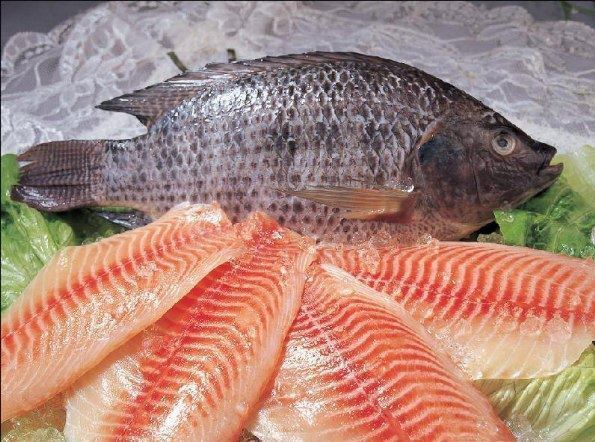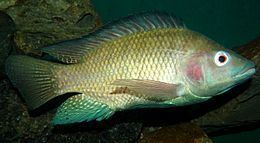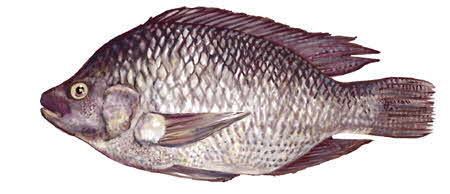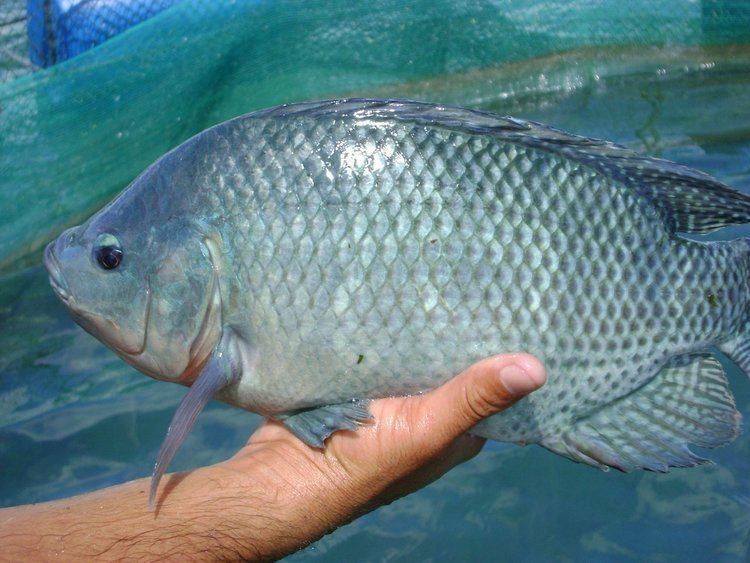Similar Fish as food, Catfish, Salmon, Fillet, Shrimp and prawn as food | ||
Tilapia (/tᵻˈlɑːpi.ə/ ti-LAH-pee-ə) is the common name for nearly a hundred species of cichlid fish from the tilapiine cichlid tribe. Tilapia are mainly freshwater fish inhabiting shallow streams, ponds, rivers and lakes and less commonly found living in brackish water. Historically, they have been of major importance in artisan fishing in Africa and the Middle East, and they are of increasing importance in aquaculture and aquaponics. Tilapia can become problematic invasive species in new warm-water habitats such as Australia, whether deliberately or accidentally introduced, but generally not in temperate climates due to their inability to survive in cold water.
Contents
- Is tilapia good for you 3 fish to eat instead of tilapia thomas delauer
- History
- Characteristics
- Species
- Exotic and invasive species
- Aquarium species
- Commercial species
- Aquaculture
- As food
- Miscellaneous uses
- References

Tilapia is the fourth most consumed fish in the United States dating back to 2002. The popularity of tilapia came about due to its cheap price, easy preparation, and its mild taste.

Is tilapia good for you 3 fish to eat instead of tilapia thomas delauer
History

Tilapia was a symbol of rebirth in Egyptian art, and was in addition associated with Hathor. It was also said to accompany and protect the sun god on his daily journey across the sky. Tilapia painted on tomb walls, reminds us of spell 15 of the Book of the Dead by which the deceased hopes to take his place in the sun boat: "You see the tilapia in its [true] form at the turquoise pool", and "I behold the tilapia in its [true] nature guiding the speedy boat in its waters."

Tilapia were one of the three main types of fish caught in Biblical times from the Sea of Galilee. At that time they were called Amnoon (which they are still called today in Modern Hebrew. Am= mother, Noon= fish.), in Arabic the fish is called "Musht", which means "a comb", as resembled by its backfin or commonly now as "St. Peter's fish". The name "St. Peter's fish" comes from the story in the Gospel of Matthew about the apostle Peter catching a fish that carried a coin in its mouth, though the passage does not name the fish. While the name also applies to Zeus faber, a marine fish not found in the area, a few tilapia species (Sarotherodon galilaeus galilaeus and others) are found in the Sea of Galilee, where the author of the Gospel of Matthew recounts the event took place. These species have been the target of small-scale artisanal fisheries in the area for thousands of years.

The common name tilapia is based on the name of the cichlid genus Tilapia, which is itself a latinisation of thiape, the Tswana word for "fish". Scottish zoologist Andrew Smith named the genus in 1840.
Characteristics
Tilapia typically have laterally compressed, deep bodies. Like other cichlids, their lower pharyngeal bones are fused into a single tooth-bearing structure. A complex set of muscles allows the upper and lower pharyngeal bones to be used as a second set of jaws for processing food (cf. morays), allowing a division of labor between the "true jaws" (mandibles) and the "pharyngeal jaws". This means they are efficient feeders that can capture and process a wide variety of food items. Their mouths are protrusible, usually bordered with wide and often swollen lips. The jaws have conical teeth. Typically tilapia have a long dorsal fin, and a lateral line which often breaks towards the end of the dorsal fin, and starts again two or three rows of scales below. Some Nile tilapia can grow as long as two feet.
Other than their temperature sensitivity, tilapia exist in or can adapt to a very wide range of conditions. One extreme example is the Salton Sea, where tilapia introduced when the water was brackish now live in saltwater so salty that it kills marine fish.
Tilapia are also known to be a mouth breeding species. Mouth breeding means they carry the fertilized eggs and young fish in their mouths for several days after the yolk sac is absorbed.
Species
Tilapia as a common name has been applied to various cichlids from three distinct genera: Oreochromis, Sarotherodon and Tilapia. The members of the other two genera used to belong to the genus Tilapia but have since been split off into their own genera. However, particular species within are still commonly called "tilapia" regardless of the change in their actual taxonomic nomenclature.
The delimitation of these genera among each other and to other tilapiines requires more research; mtDNA sequences are confounded because at least among the species of any one genus, there is frequent hybridization. The species remaining in Tilapia in particular still seem to be a paraphyletic assemblage.
Exotic and invasive species
Tilapia has been used as biological controls for certain aquatic plant problems. It has a preference for a floating aquatic plant, duckweed (Lemna sp.) but also consumes some filamentous algae. In Kenya tilapia were introduced to control mosquitoes which were causing malaria, because they consume mosquito larvae, consequently reducing the numbers of adult female mosquitoes, the vector of the disease (Petr 2000). These benefits are, however, frequently outweighed by the negative aspects of tilapia as an invasive species.
Tilapia are unable to survive in temperate climates because they require warm water. The pure strain of the blue tilapia, Oreochromis aureus, has the greatest cold tolerance and dies at 45 °F (7 °C), while all other species of tilapia will die at a range of 52 to 62 °F (11 to 17 °C). As a result, they cannot invade temperate habitats and disrupt native ecologies in temperate zones; however, they have spread widely beyond their points of introduction in many fresh and brackish tropical and subtropical habitats, often disrupting native species significantly. Because of this, tilapia are on the IUCN's 100 of the World's Worst Alien Invasive Species list. In the United States, tilapia are found in much of the south, especially Florida and Texas, also as far north as Idaho, where they survive in power plant discharge zones. Tilapia are also currently stocked in the Phoenix, Arizona canal system as an algae growth control measure. Many state fish and wildlife agencies in the United States, Australia, South Africa, and elsewhere consider them to be invasive species.
Aquarium species
Larger tilapia species are generally poor community aquarium fish because they eat plants, dig up the bottom, and fight with other fish. However, the larger species are often raised in aquariums as a food source, because they grow rapidly and tolerate high stocking densities and poor water quality.
Smaller West African species, such as Tilapia joka and species from the crater lakes of Cameroon, are more popular. In specialised cichlid aquaria, tilapia can be mixed successfully with nonterritorial cichlids, armored catfish, tinfoil barbs, garpike and other robust and dangerous fish. Some species, including Tilapia buttikoferi, Tilapia rendalli,Tilapia mariae, Tilapia joka and the brackish-water Sarotherodon melanotheron melanotheron, have attractive patterns and are quite decorative.
Commercial species
The tilapiines of North Africa are the most important commercial cichlids. Fast-growing, tolerant of stocking density, and adaptable, they have been introduced to and are farmed extensively in many parts of Asia and are increasingly common aquaculture targets elsewhere.
Aquaculture
Farmed tilapia production is about 1,500,000 tonnes (1,500,000 long tons; 1,700,000 short tons) annually with an estimated value of US$1.8 billion, about equal to that of salmon and trout.
Unlike carnivorous fish, tilapia can feed on algae or any plant-based food. This reduces the cost of tilapia farming, reduces fishing pressure on prey species, avoids concentrating toxins that accumulate at higher levels of the food chain and makes tilapia the preferred "aquatic chickens" of the trade.
Because of their large size, rapid growth, and palatability, tilapiine cichlids are the focus of major farming efforts, specifically various species of Oreochromis, Sarotherodon, and Tilapia, collectively known colloquially as tilapia. Like other large fish, they are a good source of protein and popular among artisanal and commercial fisheries. Most such fisheries were originally found in Africa, but outdoor fish farms in tropical countries, such as Papua New Guinea, the Philippines, and Indonesia, are underway in freshwater lakes. In temperate zone localities, tilapiine farming operations require energy to warm the water to tropical temperatures. One method uses waste heat from factories and power stations.
At 1.3 million tonnes per annum, China is the largest tilapia producer in the world, followed by Egypt with 0.5 million. The US, by comparison, produces 10 thousand tonnes against a consumption of 2.5 million.
In modern aquaculture, wild-type Nile tilapia are not too often seen, as the dark color of their flesh is not much desired by many customers, and because it has a bit of a reputation of being a trash fish associated with poverty. On the other hand, they are fast-growing and give good fillets; leucistic ("Red") breeds which have lighter meat have been developed and these are very popular.
Hybrid stock is also used in aquaculture; Nile × blue tilapia hybrids are usually rather dark, but a light-colored hybrid breed known as "Rocky Mountain White" tilapia is often grown due to its very light flesh and tolerance of low temperatures.
Commercially grown tilapia are almost exclusively male. Cultivators use hormones, such as testosterone, to reverse the sex of newly spawned females. Because tilapia are prolific breeders, the presence of female tilapia results in rapidly increasing populations of small fish, rather than a stable population of harvest-size animals.
Other methods of tilapia population control are polyculture, with predators farmed alongside tilapia or hybridization with other species.
As food
Whole tilapia fish can be processed into skinless, boneless (Pin-Bone Out, or PBO) fillets: the yield is from 30 percent to 37 percent, depending on fillet size and final trim.
Tilapia is one of several commercially important aquaculture species (including trout, barramundi and channel catfish) susceptible to off-flavors. These 'muddy' or 'musty' flavors are normally caused by geosmin and 2-methylisoborneol, organic products of ubiquitous cyanobacteria that are often present or bloom sporadically in water bodies and soil. These flavours are no indication of freshness or safety of the fish, but they make the product unattractive to consumers. Simple quality control procedures are known to be effective in ensuring the quality of fish entering the market.
In a freshwater soilless pond system the fish will not have these flavors. Fish raised in man-made lakes tend to absorb the flavor of the ground. A concrete pond with plants to clean the water is a much better system. It is also important that the fish only get fed as much food as they can eat. If the food is left over in the tank it will break down in the water leaving a bad odor that leads to an unwanted taste in the fish.
Tilapia have very low levels of mercury, as they are fast-growing, lean and short-lived, with a primarily vegetarian diet, so do not accumulate mercury found in prey. Tilapia are low in saturated fat, calories, carbohydrates and sodium, and are a good protein source. They also contain the micronutrients phosphorus, niacin, selenium, vitamin B12 and potassium.
Multiple studies have evaluated the effects of adding flaxseed derivatives (a vegetable source of omega-3 fatty acids) to the feed of farmed tilapia. These studies have found both the more common omega-3 fatty acid found in the flax, ALA and the two types almost unique to animal sources (DHA and EPA), increased in the fish fed this diet. Guided by these findings, tilapia farming techniques could be adjusted to address the nutritional criticisms directed at the fish while retaining its advantage as an omnivore capable of feeding on economically and environmentally inexpensive vegetable protein. Adequate diets for salmon and other carnivorous fish can alternatively be formulated from protein sources such as soybean, although soy-based diets may also change in the balance between omega-6 and omega-3 fatty acids.
Miscellaneous uses
Tilapia serve as a natural, biological control for most aquatic plant problems. Tilapia consume floating aquatic plants, such as duckweed watermeal (Lemna sp.), most "undesirable" submerged plants, and most forms of algae. In the United States and countries such as Thailand, they are becoming the plant control method of choice, reducing or eliminating the use of toxic chemicals and heavy metal-based algaecides.
Tilapia rarely compete with other "pond" fish for food. Instead, because they consume plants and nutrients unused by other fish species and substantially reduce oxygen-depleting detritus; adding tilapia often increases the population, size and health of other fish. They are used for zoo ponds as a source of food for birds.
For example, tilapia can be farmed together with shrimps in a symbiotic manner positively enhancing the productive output of both.
Arizona stocks tilapia in the canals that serve as the drinking water sources for the cities of Phoenix, Mesa and others. The fish help purify the water by consuming vegetation and detritus, greatly reducing purification costs.
Arkansas stocks many public ponds and lakes to help with vegetation control, favoring tilapia as a robust forage species and for anglers.
In Kenya, tilapia help control mosquitoes which carry malaria parasites. They consume mosquito larvae, which reduces the numbers of adult females, the disease’s vector.
In Brazil, tilapia fish skin is being used in a new clinical trial to treat burn injuries.
Tilapia also provide an abundant food source for aquatic predators.
